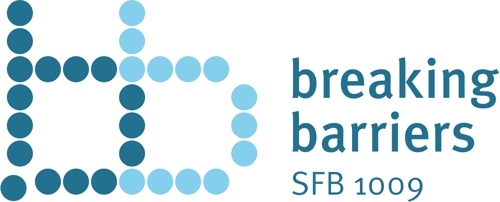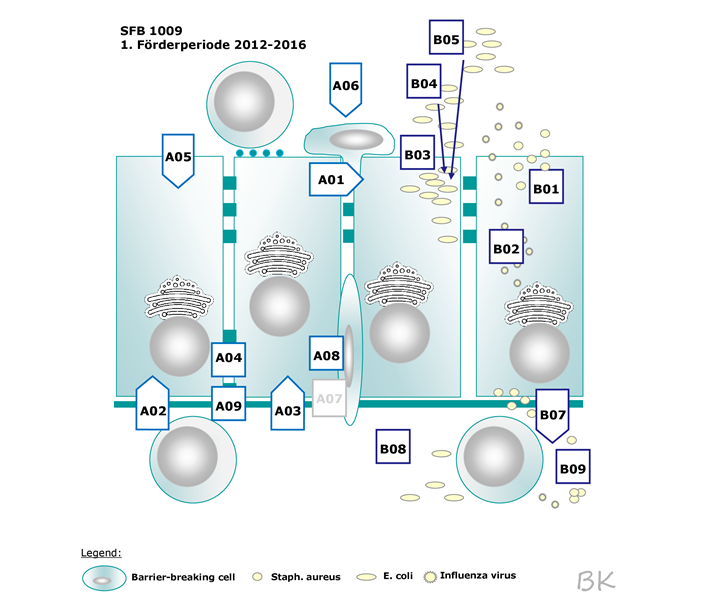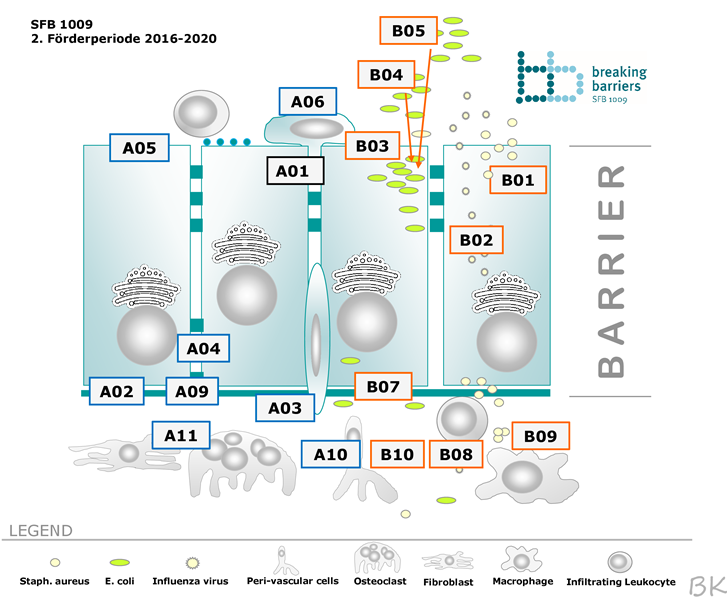Research
Biological barriers organize compartmentalization within multi-cellular organisms, thereby controlling a number of pivotal processes of cells and perturbations of barrier functions are central in many inflammatory diseases. The Collaborative Research Centre (CRC) 1009 addresses fundamental aspects of the formation, function and penetration of biological barriers in homeostasis and inflammatory diseases.
Barriers studied in the CRC are endothelial and epithelial monolayers and their associated basement membranes, including those found in the lung, gut, skin and brain. CRC 1009 is structured into two closely linked areas focussing on the development, structure, integrity and cellular penetration of barriers (Research Area A), and the role of barriers as integrative structures for immune responses in infections, allergic and autoimmune diseases (Research Area B).
By combining expertise in the fields of immunology, cell biology, microbiology and infectiology and including clinical partners from dermatology, neurology, anaesthesiology and internal medicine, we formed an internationally unique and highly interactive research network at the University of Münster (WWU). Our interdisciplinary approach addressing barrier physiology and pathology resulted in important findings in the past funding period. Among other things, members of CRC 1009 obtained novel insights into the process of barrier formation, unravelled new mechanisms of recruitment, activation and diapedesis of leukocytes and tumour cells, identified unknown strategies used by bacteria and viruses to infect barrier-forming and -penetrating cells and also discovered novel pathways of immune regulation. Importantly, this resulted in the identification of potential targets for future approaches to treat infectious and sterile inflammatory diseases at biological interphases.
Towards a mechanistic understanding of inflammation at biological barriers we will now focus on the functional analysis of endothelial and epithelial layers and their associated cells using sophisticated methods, dynamic in vivo and high-resolution imaging, innovative high-throughput technologies and a growing library of experimental and patient-derived viral and bacterial pathogens.
In addition, we will extend our work to innovative therapeutic approaches in preclinical models, and will analyse disease-specific mechanisms in patient-derived inducible pluripotent stem cells. Translational approaches will also benefit from cohorts of patients suffering from infectious, allergic and autoimmune disorders showing inflammation at barriers in the vasculature, gut, skin, lung, brain, and urinary tract.
Our combined efforts will lead to a more comprehensive and dynamic understanding of barrier biology during homeostasis and inflammation, rather than restricting our view on individual barrier components.
Research Area A - Development, structural integrity and cellular penetration of barriers
Research Area B - Role of barriers as integrative structures for immune responses in infections, allergic and autoimmune diseases



